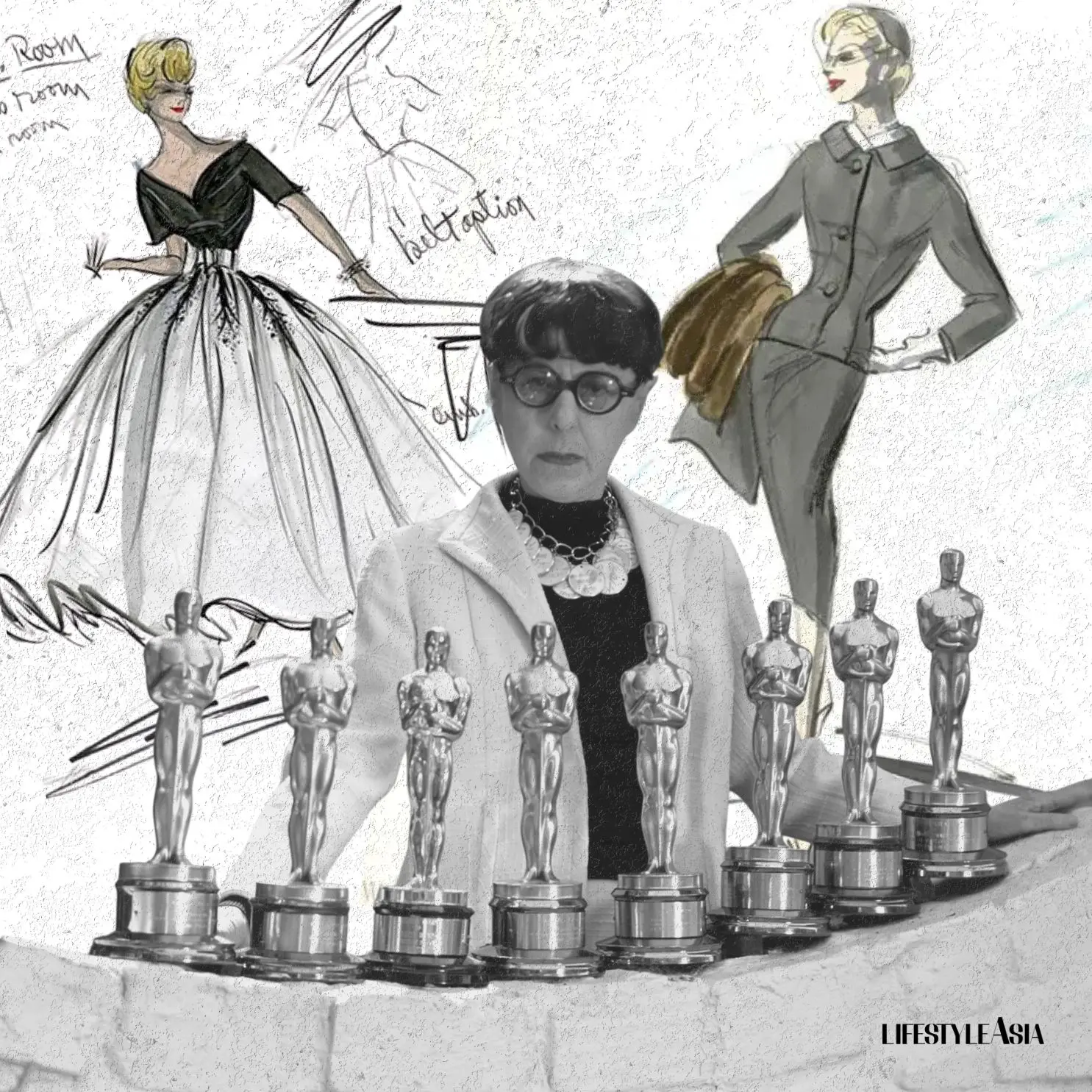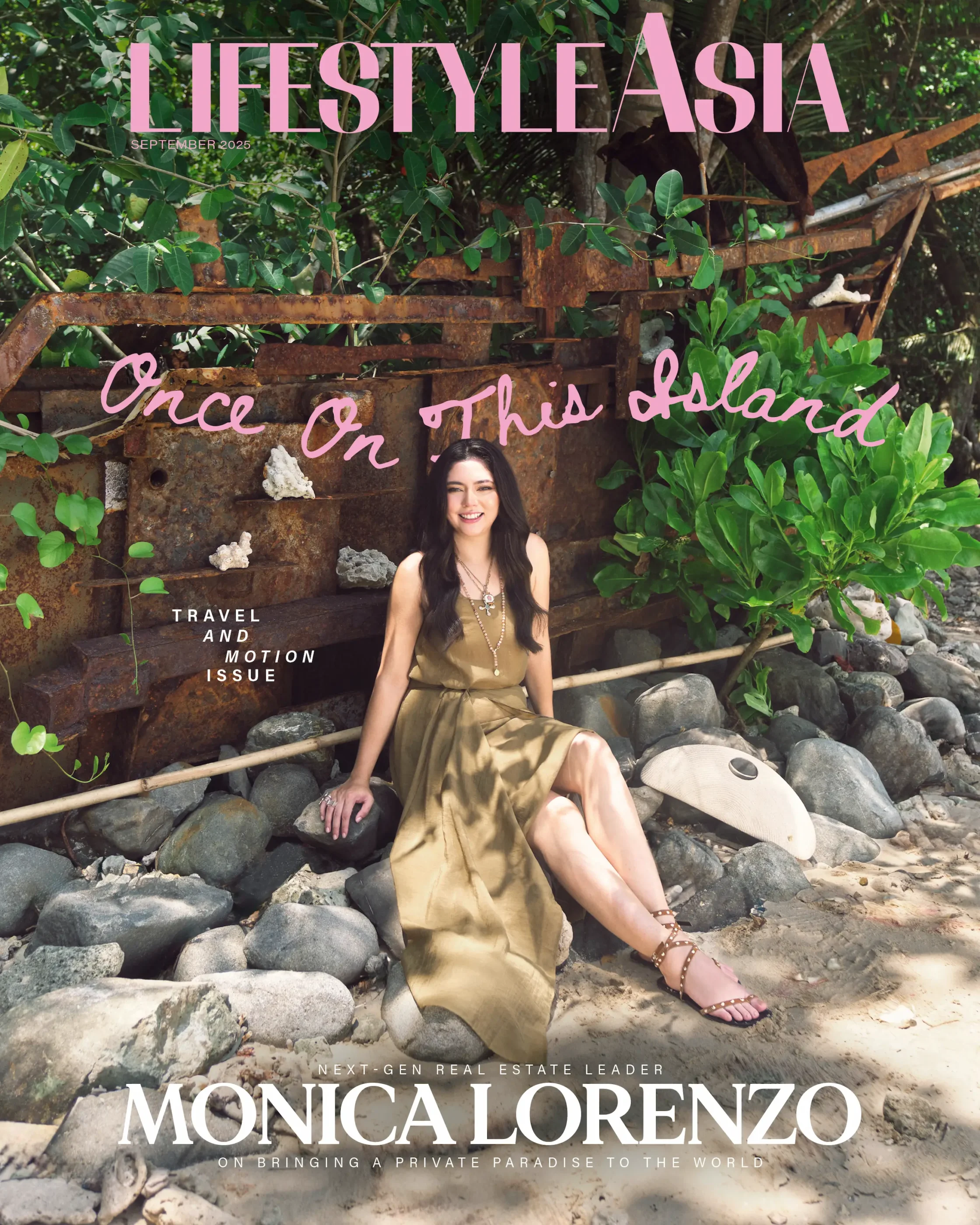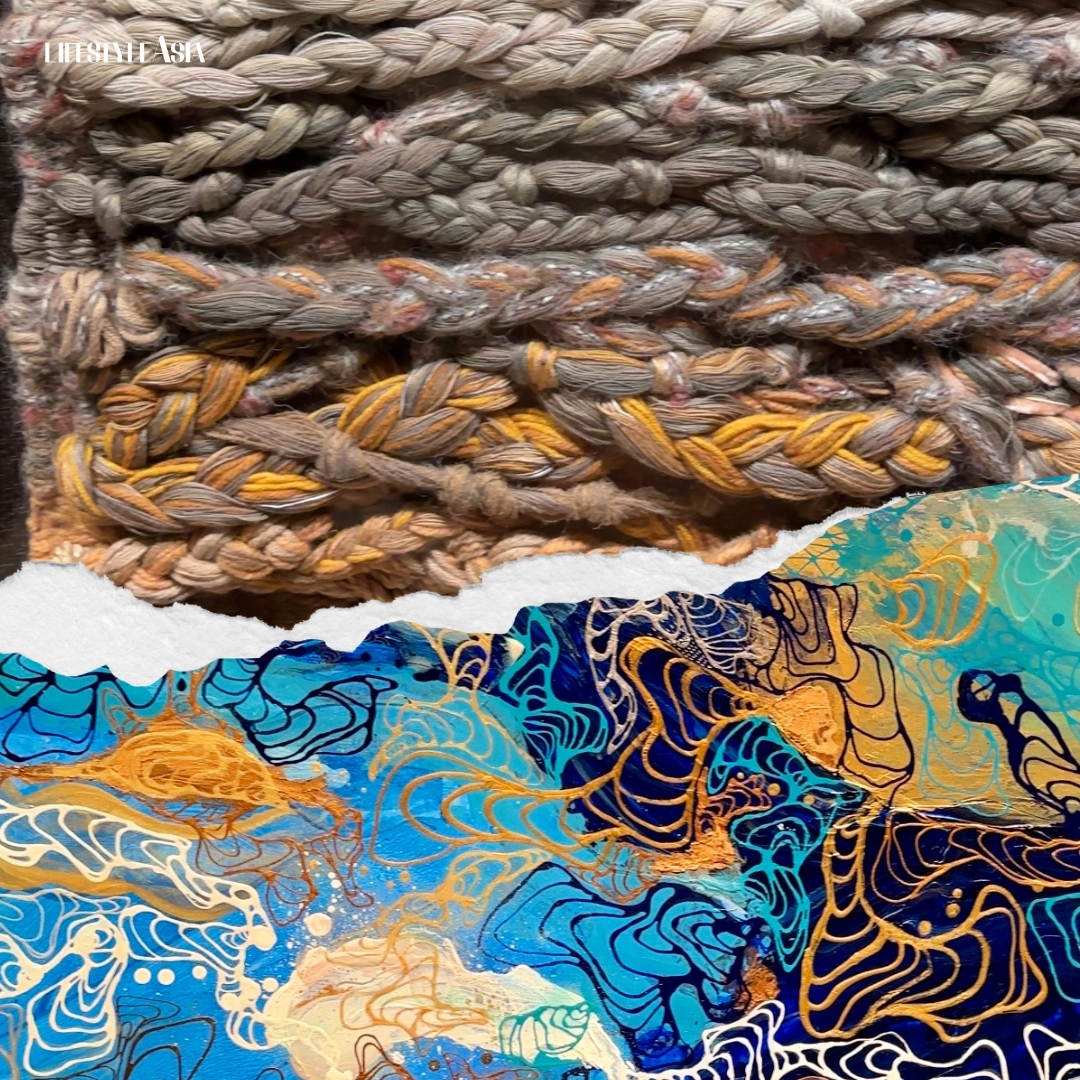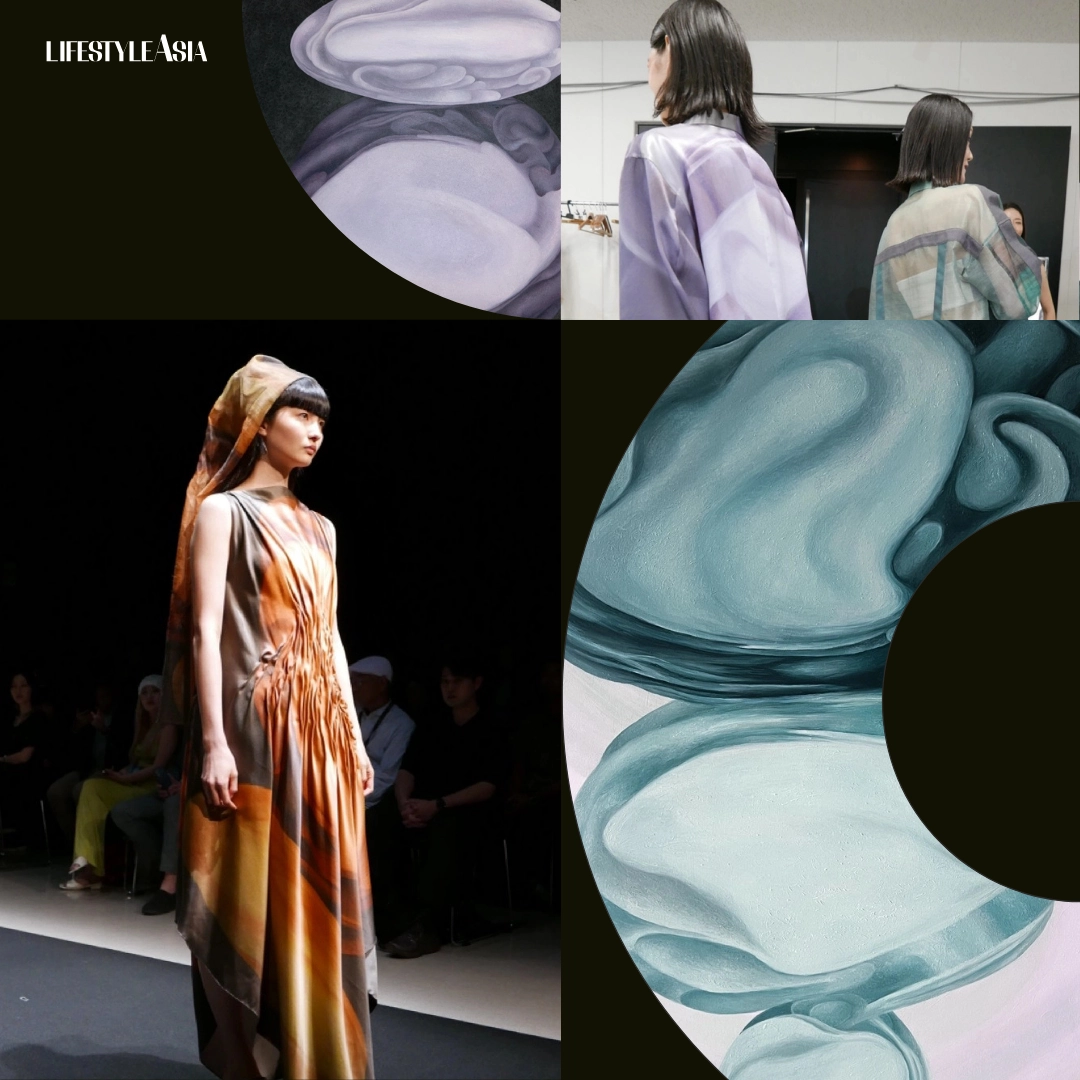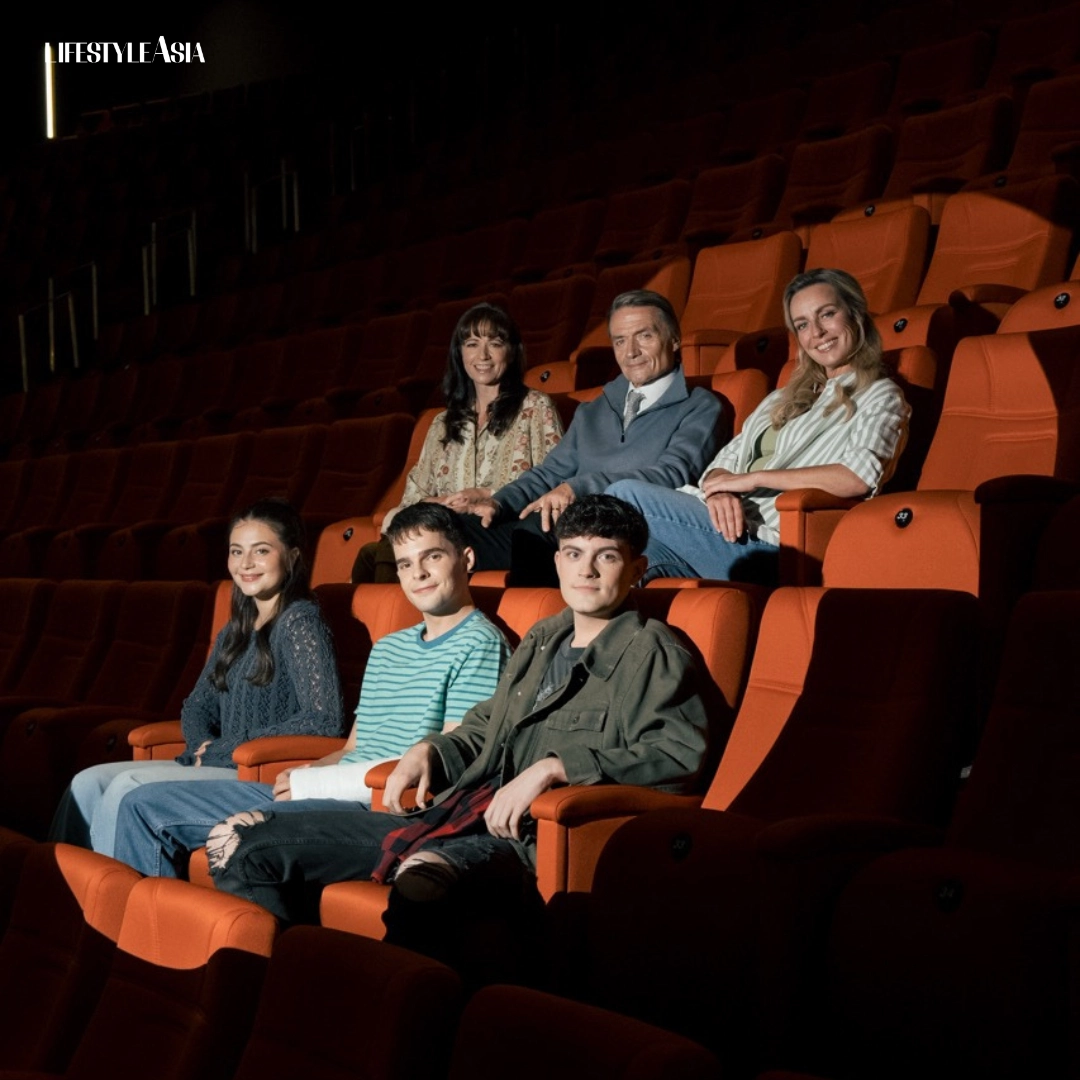To honor legendary costume designer Edith Head, we look at ten of her films and the wardrobes that shaped not only their stories, but also fashion and cinema as a whole.
Before the couturiers of Paris and New York became household names, people looked to the movies for fashion inspiration. Designers like Gilbert Adrian and Orry-Kelly dressed the actresses of the 1930s and ’40s, ultimately defining the era with their iconic movie-star glamour. In the 1950s, no costume designer reigned more supremely than Edith Head, who helmed the costume design department at Paramount Pictures, and whose remarkable career spanned over five decades.
Her influence extended far beyond the studio gates. Head’s popularity made her the top choice of Hollywood’s most notable stars, including Grace Kelly, Audrey Hepburn, and Elizabeth Taylor, with many of their iconic on- and off-screen outfits designed by her. Head’s resume between 1949 and 1978 resulted not only in a remarkable body of work but also 35 Academy Award nominations and eight wins—making her still the most awarded woman in the awards’ history. And rightfully so. She defined an era, with many of her creations remaining influential to this day.
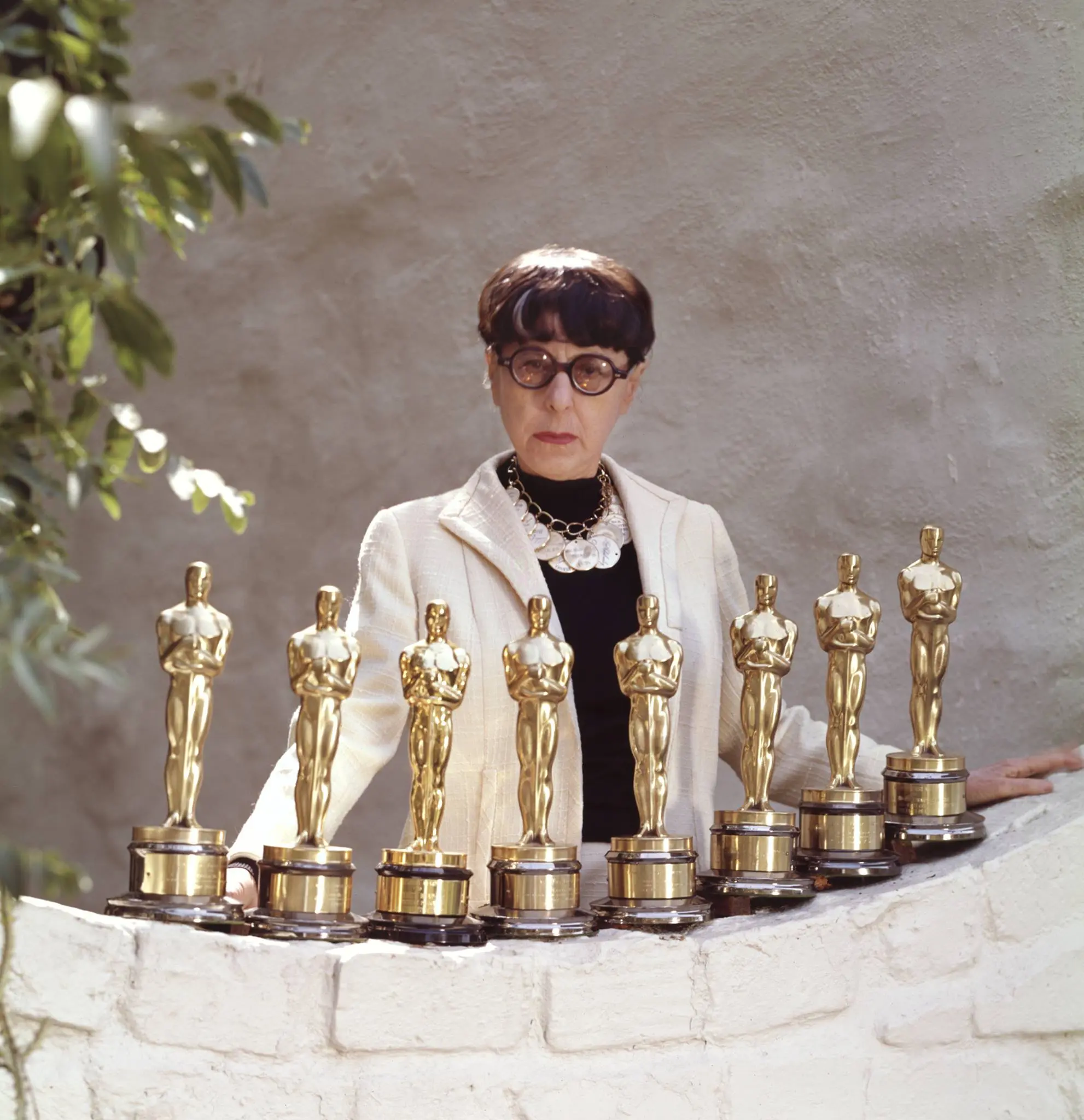
Yet her journey to becoming Hollywood’s most celebrated costume designer was far from glamorous. In the early 1920s, she began a humble career at Paramount as a costume sketcher, but her creativity and talent quickly shone through as she designed for films of the silent era. By 1938, she secured her place as one of cinema’s leading talents and was appointed Chief Costume Designer at Paramount, becoming the first woman in Hollywood to oversee a major studio’s costume department. She held the position until 1967, when she moved to Universal Pictures (likely to continue her collaboration with Alfred Hitchcock, who had transferred there in 1960).
Even after her move to Universal, it was her decades at Paramount that defined her legendary status. As she famously said, “If it’s a Paramount film, I probably designed it.” And she was right to be proud: her tenure at the studio made her one of the most prolific costume designers in history—so prolific, in fact, that at times she couldn’t even recall which films she designed for.
Edith Head passed away in 1981 from a bone marrow disease, but she lives on. Her legacy is cemented in both Oscar gold and the vibrant films that showcase her talent. In modern pop culture, her iconic look (marked by a signature bob and dark sunglasses) inspired the creation of Edna Mode, the beloved costume designer from The Incredibles who was modeled after her.
To honor her brilliance, we look back at 10 great Edith Head films and explore how her costumes elevated the overall quality of the motion picture.
All About Eve (1950)
Fresh from an Oscar win for the previous year’s The Heiress (1949), Edith Head won her second and third Academy Awards in 1950 for Samson and Delilah (Best Color Costume Design) and All About Eve (Best Black-and-White Costume Design). The latter, which also won that year’s Best Picture prize, has since remained a classic. It tells the story of Margot Channing (Bette Davis), an aging Broadway star whose life is turned upside down when her seemingly meek superfan-turned-assistant, Eve (Anne Baxter), begins trying to steal her life and career.
Head meticulously crafted costumes that captured the many spectrums of New York high society and the theater world. From Davis’s impeccably tailored dark ensembles (which fit her fussy diva persona like a glove) to Anne Baxter’s frumpy assistant coats and dresses, All About Eve is a masterclass in women’s wear and power dressing.
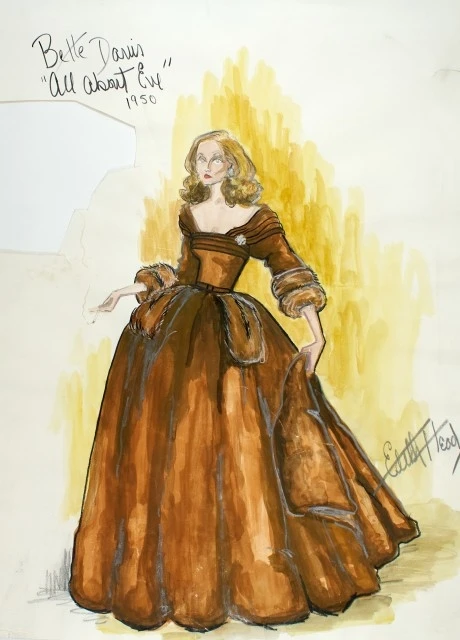
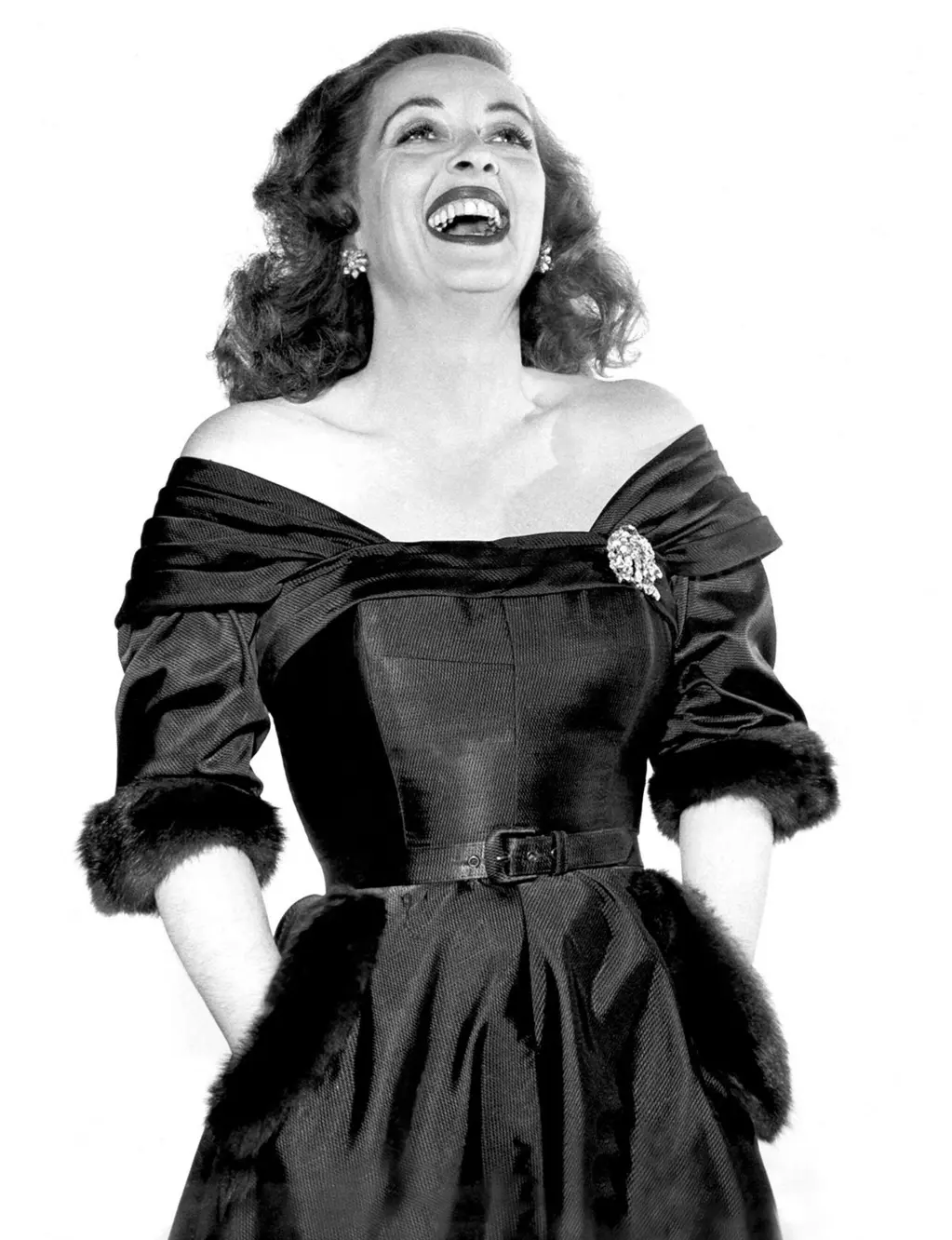
The most iconic piece is Davis’s brown evening gown with fur trimming, worn in the famous party sequence, which was a happy accident. The dress had been rushed due to time constraints, and when Davis tried it on the night before filming, it was far too large. While Edith Head feared director Joseph L. Mankiewicz would be furious, she and Davis chose to embrace the mistake, pulling down the sleeves and transforming it into the unforgettable off-shoulder gown we see on screen today.
Sunset Boulevard (1950)
Despite the massive success of Billy Wilder’s Sunset Boulevard, Edith Head was surprisingly overlooked during the Academy Awards for her work on the film (though she did win two Oscars that same night anyway). Still, her creations are striking and impeccably suited to the film’s story. She collaborated closely with actress Gloria Swanson in dressing Norma Desmond—the fading silent film star, deluded yet determined to make a grand Hollywood comeback with the help of Joe Gillis (William Holden), a struggling young screenwriter. The two begin a doomed love affair in Norma’s decrepit house of horrors, and it isn’t long before her mind starts to unravel even further.
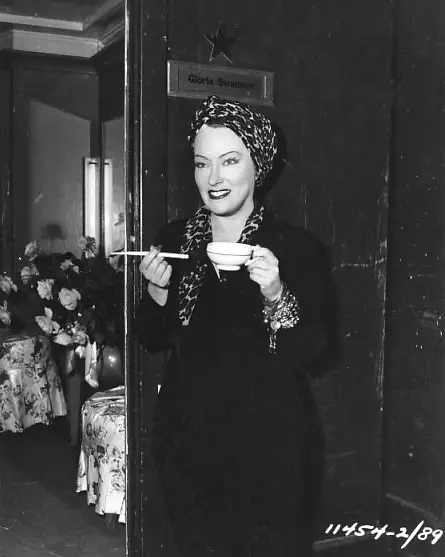
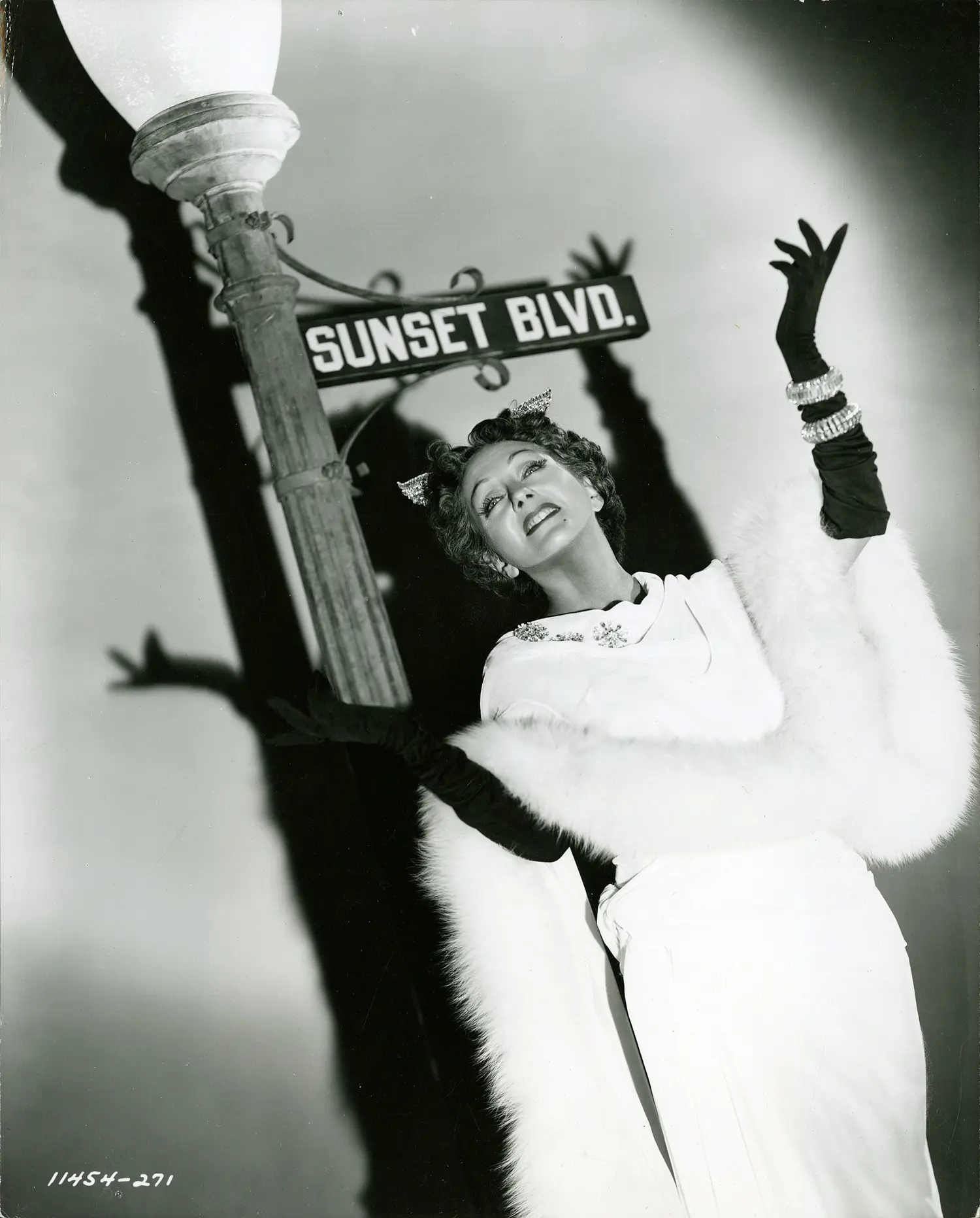
Sunset Boulevard was considered shocking at the time for its dark portrayal of Hollywood. Swanson, a leading figure of the Silent Era, was praised for her vanity-free performance as a forgotten movie star. While her work deserves full credit, Edith Head must also be acknowledged. The costumes she designed for the actress helped create one of the most iconic characters in cinema history. Norma had to be luxe and dramatic, yet also strange and deranged, as though her wardrobe were relics from the 1920s, the height of her fame. Together, Swanson and Head nailed this vision with opulent furs, metallic gowns, and iconic turbans—everything you’d imagine a 1920s movie star would desperately cling to. It’s gorgeous, character-driven work.
A Place in the Sun (1951)
In the 1951 classic A Place in the Sun, Elizabeth Taylor’s character, socialite Angela Vickers, is introduced in a stunning Edith Head creation: a white evening gown adorned with flowers across the bodice. When the film premiered, the dress became as much a sensation as the movie itself, quickly turning into one of the most copied prom and wedding gowns of the decade, reproduced by department stores across the United States. Though Head earned no royalties from this boom in popularity, she was rewarded with another Academy Award for her work on the movie.
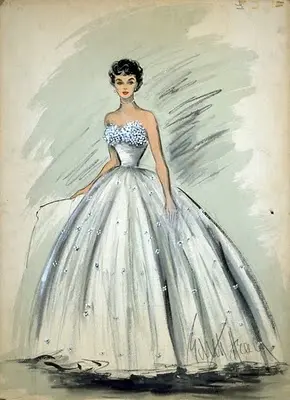
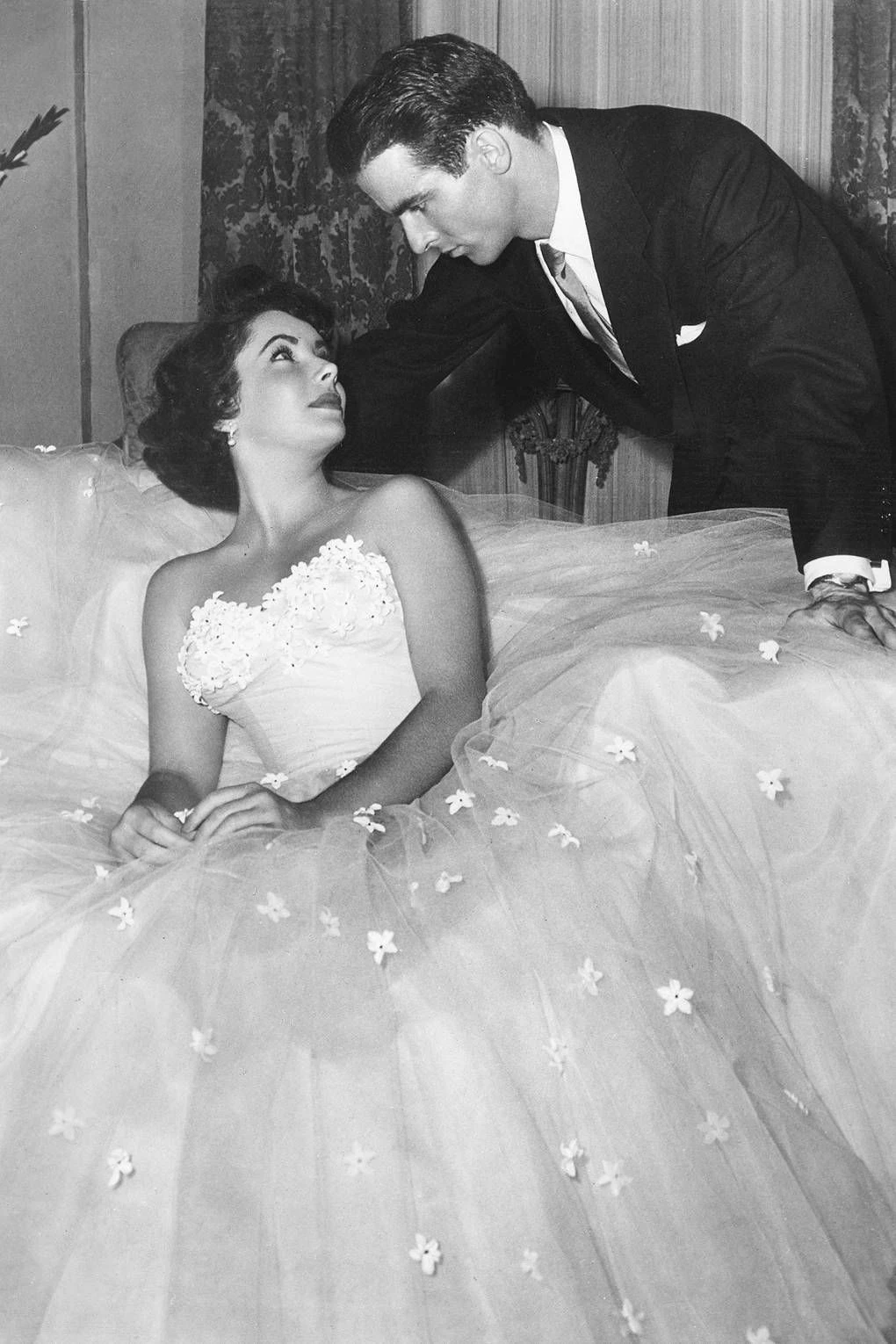
The film, based on the 1925 novel An American Tragedy by Theodore Dreiser, is often considered one of the greatest ever made. It stars Montgomery Clift as George Eastman, a poor young man whose job with a wealthy uncle introduces him to the world of high society. Eager to embrace this new life, he begins courting the glamorous “It-Girl” Angela Vickers, while neglecting (and ultimately betraying) his meek girlfriend, Alice (Shelley Winters). How far will George go to preserve his perfect new existence? Will he cast Alice aside, even fatally, especially when she reveals she’s carrying his child? The film ventures into dark territory, exploring themes of murder, the corrupting lure of the American Dream, and the destructive power of wealth. It is a masterpiece—one made even richer by its impeccably dressed characters.
Roman Holiday (1953)
Roman Holiday was the very first collaboration between Edith Head and Audrey Hepburn, who was making her feature film debut. Hepburn plays Princess Ann, a young royal from a nameless European country who, weary of her duties while on an official tour, decides to escape and explore Rome for a day. By chance, she meets a young American named Joe Bradley (Gregory), who promises to show her around town. What she doesn’t know is that Joe is actually a journalist hunting for an exclusive scoop. The result is a romantic comedy for the ages, filled with delightful, lighthearted moments, timeless iconography, and a landmark performance that introduced the world to Hepburn’s charms.
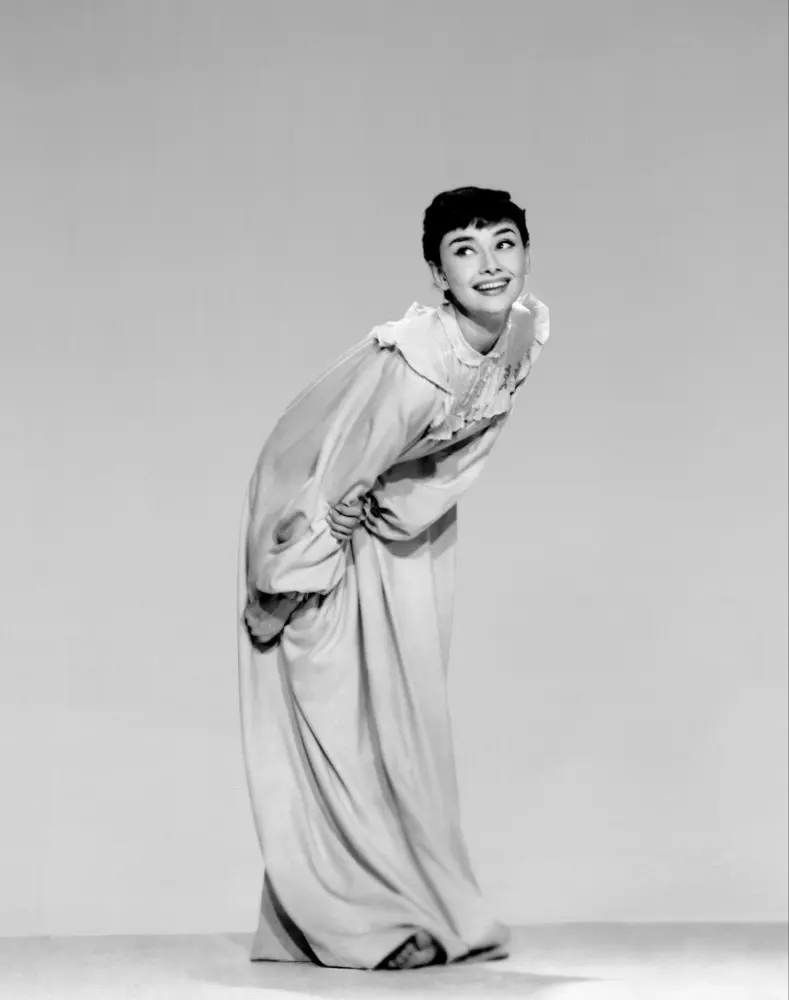
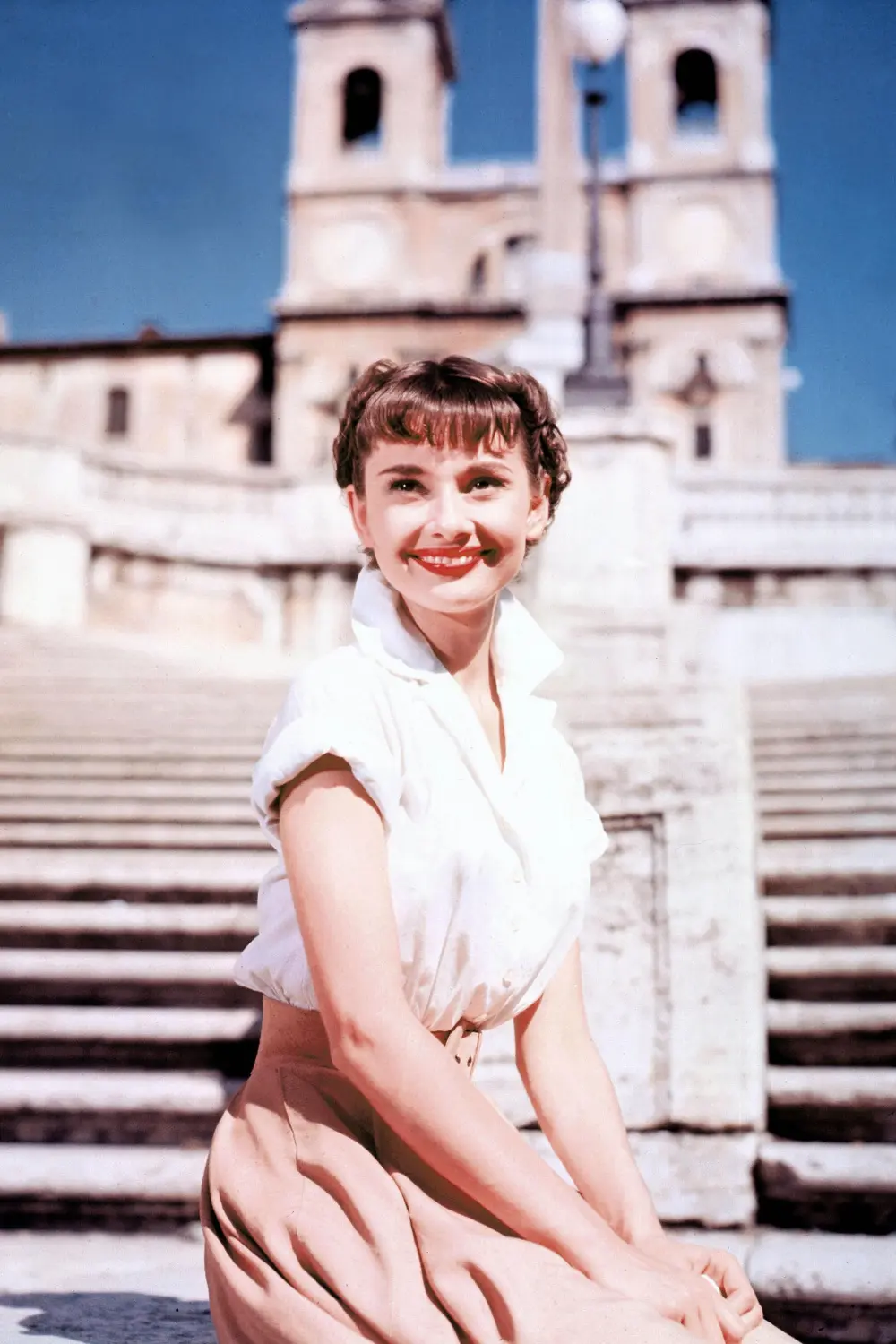
What’s impressive about Roman Holiday is Edith Head’s restraint. By this point, she was at the top of her game, designing extravagant gowns for Hollywood’s biggest stars. Yet the plot of the film, spanning only two days, didn’t give Head much to work with. Still, she made every costume count. We first see Hepburn in a beautiful formal ball gown; then a silk night dress fit for royalty; followed by an everyday Italian-inspired ensemble made up of a white blouse, poodle skirt, and scarf (perfect for her Roman adventure); and finally, that elegant white lace dress for the film’s finale. Four understated yet unforgettable looks in a work that spans almost two hours? Success. Edith Head walked away with yet another Academy Award, proving that her eye for subtle costumes was just as sharp as her flair for bold, glamorous designs.
READ ALSO: The 10 Most “Loverly” Audrey Hepburn Movies
Sabrina (1954)
While Audrey Hepburn and Edith Head worked well together on Roman Holiday, their later collaborations were far less harmonious—and it all started with Sabrina, arguably the most controversial film in Head’s career. After finishing Roman Holiday and just before production on Sabrina, Hepburn traveled to Paris to shop for her character’s wardrobe. There, she discovered a budding French designer named Hubert de Givenchy and quickly fell for his modern, elegant style. Hepburn purchased her now-iconic white floral Sabrina gown—along with several other ensembles—using her own money, and brought them back to Hollywood for the film.
This caused a major stir at the studio, as Head was known to be fiercely protective of her credit as Paramount’s chief costume designer. Because she approved Givenchy’s dresses for the film, the sole costume credit went to her. The pieces from Sabrina—most famously the Givenchy-designed necklines that came to be known as “The Sabrina Neckline”—ignited an international craze, inspiring countless imitations by dressmakers around the world. Riding that wave of popularity, Head received another Oscar: this time for designs that weren’t entirely her own. This left Givenchy publicly snubbed and understandably bitter. To be fair, she did contribute to the film—Sabrina’s pre-transformation wardrobe and a few casual looks—but can we really say the Oscar was for that?
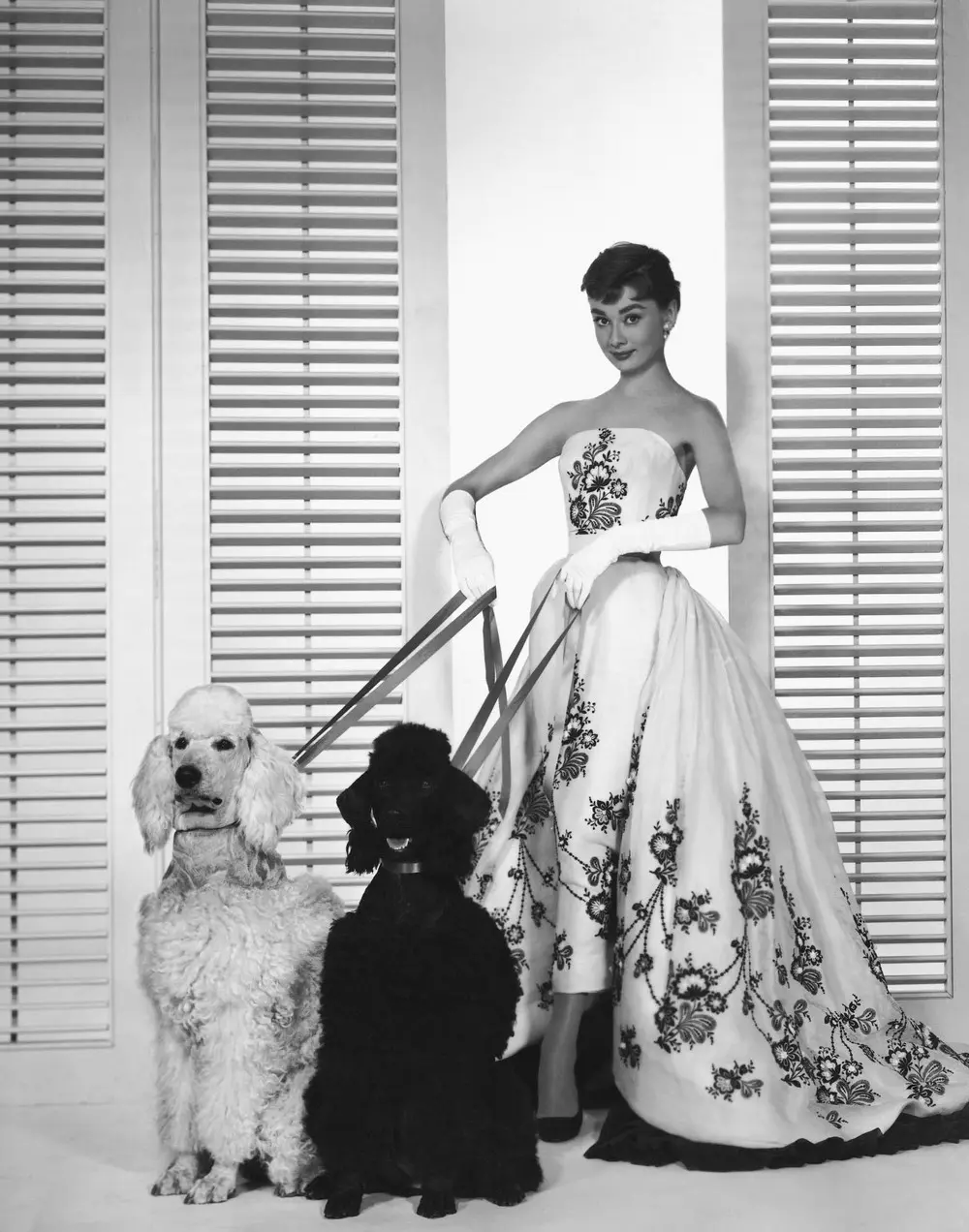
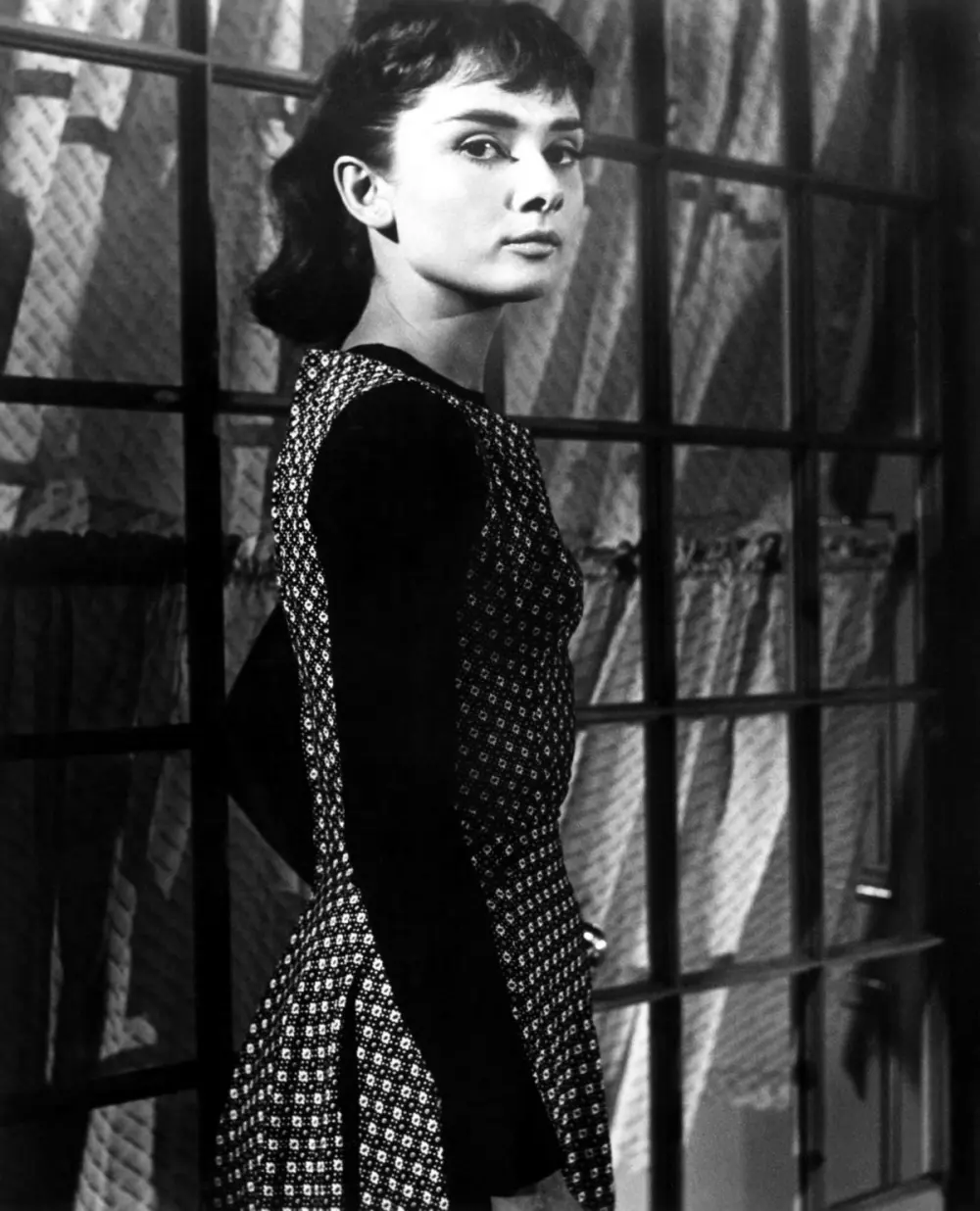
Scandal aside, Sabrina really is a costume designer’s dream movie. It’s a modern Cinderella story set in Long Island, where we follow the titular character, a chauffeur’s daughter who is madly in love with David Larrabee (William Holden), the boss’s wealthy but useless younger son. Sabrina is then sent off to Paris to learn how to cook for the family, but ultimately transforms into a sophisticated lady after befriending a kind baron who teaches her the ways of the world. Upon returning to New York, she has one mission: to win David’s heart. However, older brother Linus (Humphrey Bogart) cannot let that happen. David is engaged to another woman, and their union would bring in millions for the family’s company. Linus resolves to take care of the Sabrina problem by trying to romance her himself.
Society balls, swoon-worthy dates, and luxe office buildings give the characters of Sabrina the chance to dress up in beautiful clothing. Regardless of the controversy, no matter who designed what, the costumes are so iconic that the film still deserves to be celebrated as a collective triumph.
Rear Window (1954)
Future Princess of Monaco Grace Kelly was a vocal champion of the Hollywood designer. Both were contract players at Paramount Pictures, so it was inevitable they would meet—especially since Head often worked closely with Alfred Hitchcock, who in 1954 had found a new “Hitchcock Blonde” muse in Kelly. Their collaborations over the years produced both cinematic masterpieces and unforgettable fashion moments. Beyond the screen, Kelly continued to wear Head’s creations, even accepting her Best Actress Oscar for The Country Girl in a mint green satin gown by the designer—now regarded as one of the greatest Oscar dresses of all time.
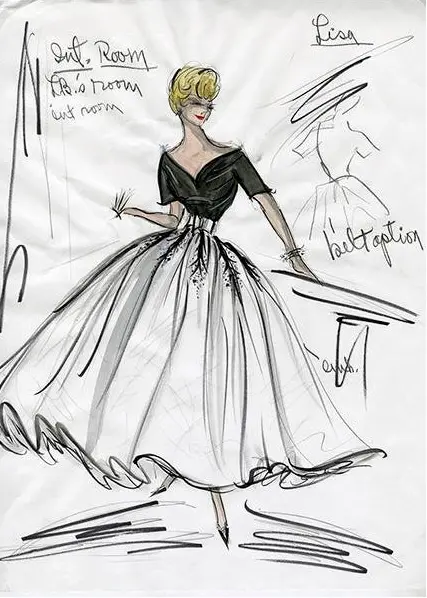
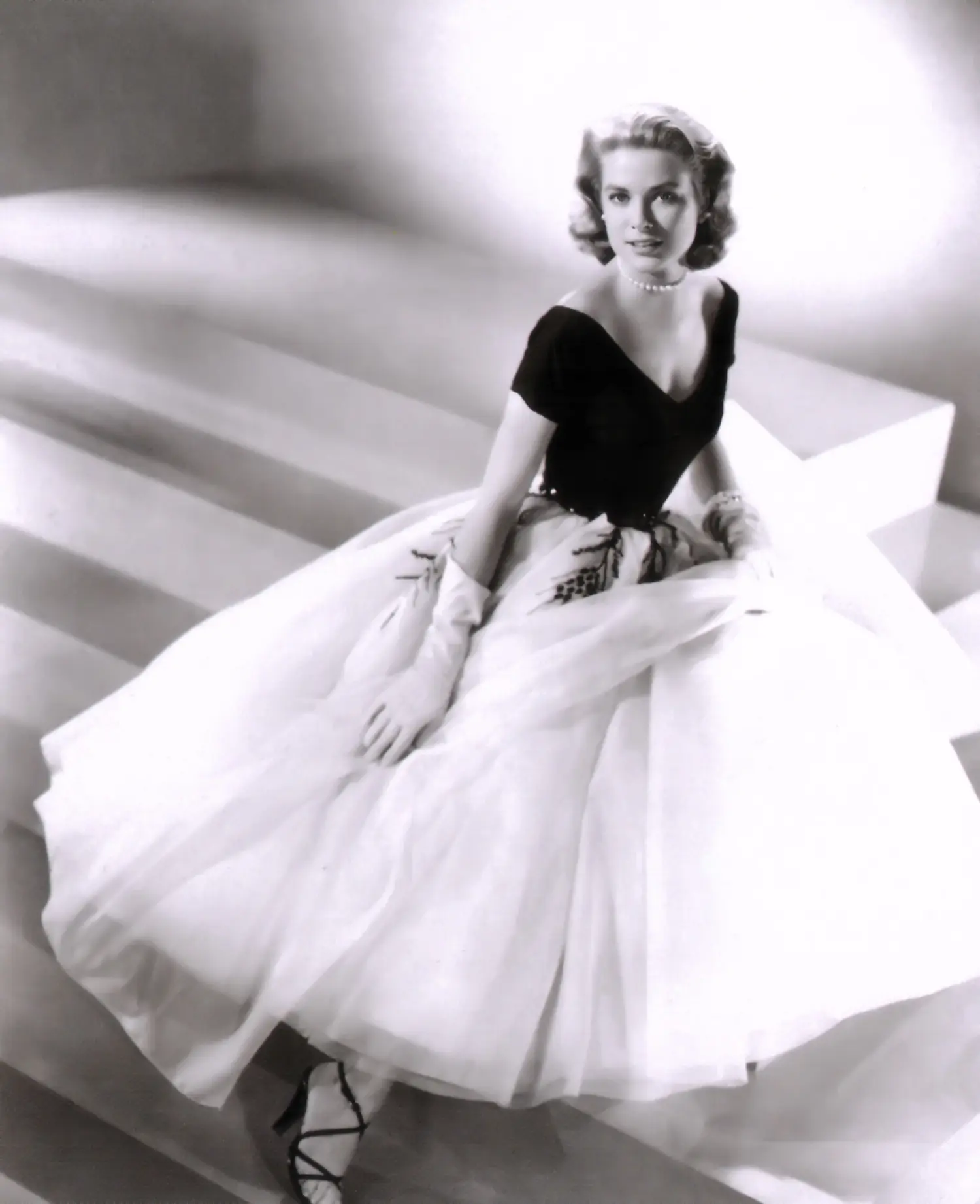
Their collaboration in Rear Window, Alfred Hitchcock’s nail-biting thriller about a wheelchair-bound photographer (James Stewart) investigating a neighborhood murder from his apartment, is pure fashion gold. Kelly plays Stewart’s socialite girlfriend, whose involvement with him entangles her in a horrific chain of events. It’s a great film—and an even better excuse to see Kelly in some of the most elegant Edith Head creations ever put on screen. From her black-and-white cocktail dress to her casual lime green tailored suit, the outfits in Rear Window look like they belong in the shop windows of Bendel’s during the 1950s. Were they appropriate for a murder mystery? Definitely not. But who cares? It’s Hollywood glamour.
White Christmas (1954)
1954, as you can probably tell by now, was a banner year for Edith Head despite the Givenchy scandal. Her gift for beautiful design was on display in numerous other films, including a personal favorite of mine, White Christmas—the holiday musical featuring the songs of Irving Berlin, often considered the unofficial sequel to 1942’s Holiday Inn. What makes White Christmas’s wardrobe so special isn’t just the luxe gowns and playful stage costumes worn by the two female leads, but the fact that—for the first time—it truly showcases Edith Head’s remarkable talent for menswear design. Danny Kaye, in particular, is dressed in moveable, tailored suits, trousers, polos, and even handmade shoes that not only make him look impossibly dapper, but also enhance his dance performances. These are clothes designed to move with the performer. The standout: a sleek grey suit paired with matching grey suede shoes, which mark one of the finest menswear moments of the 1950s.
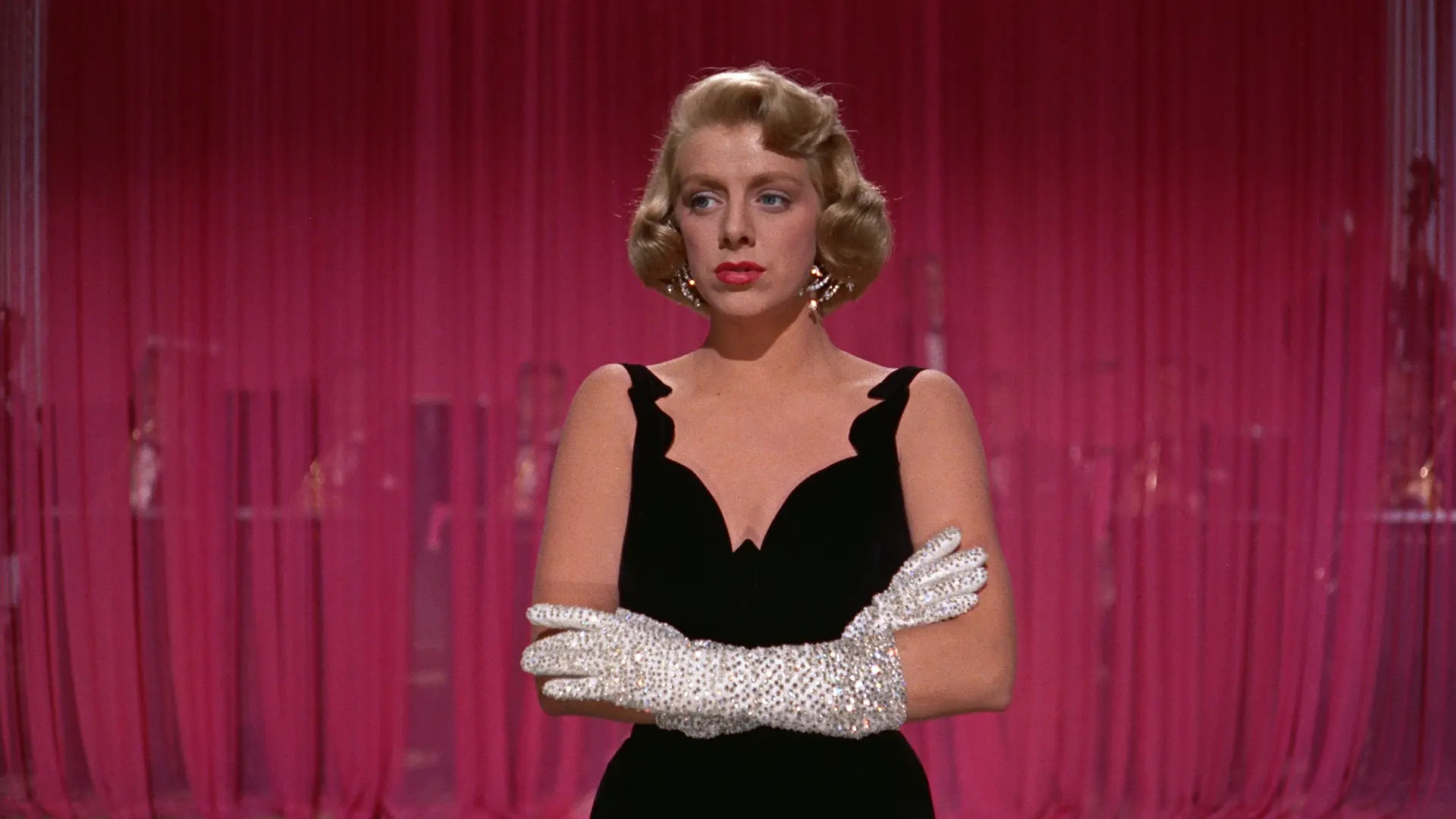
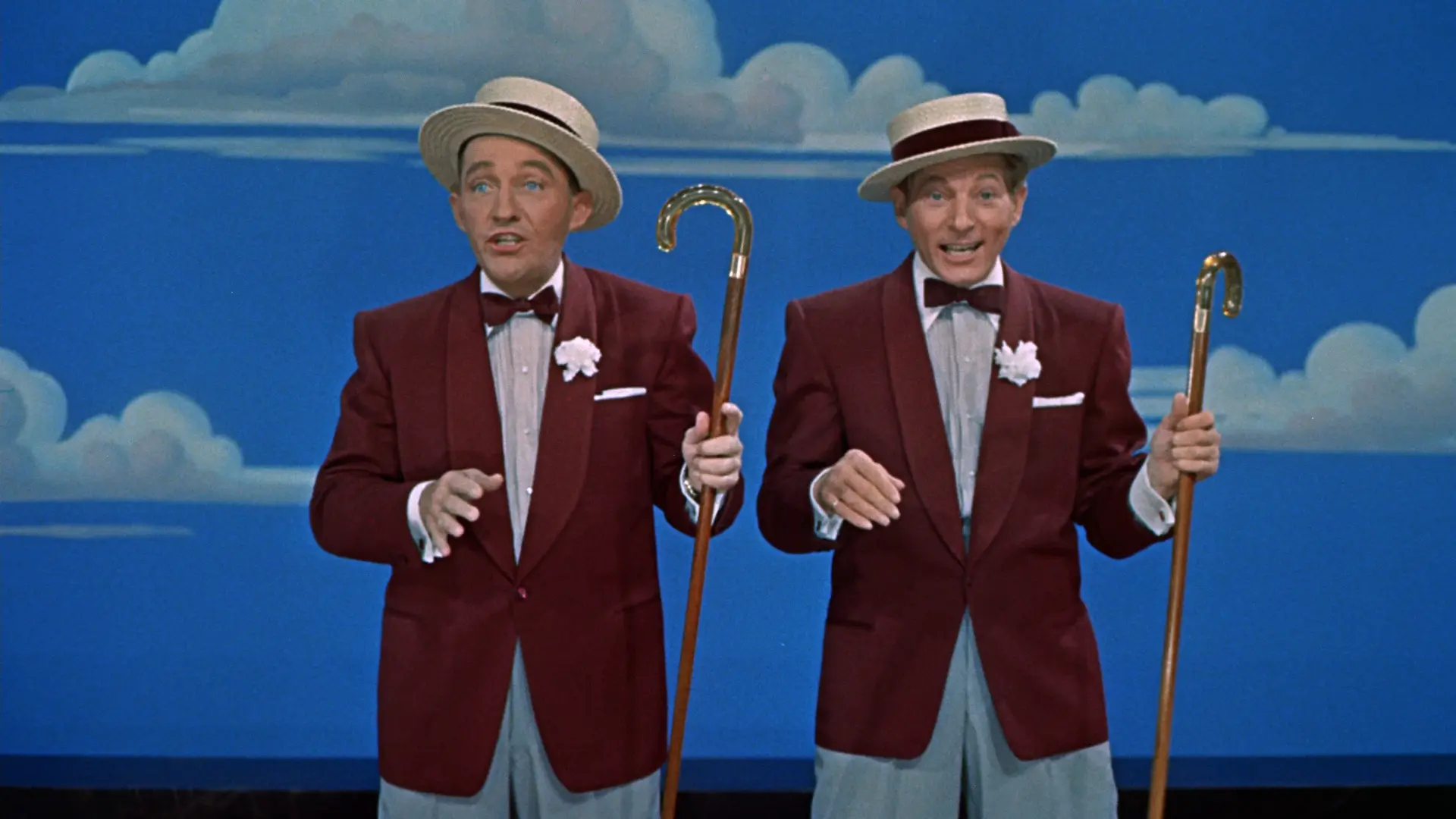
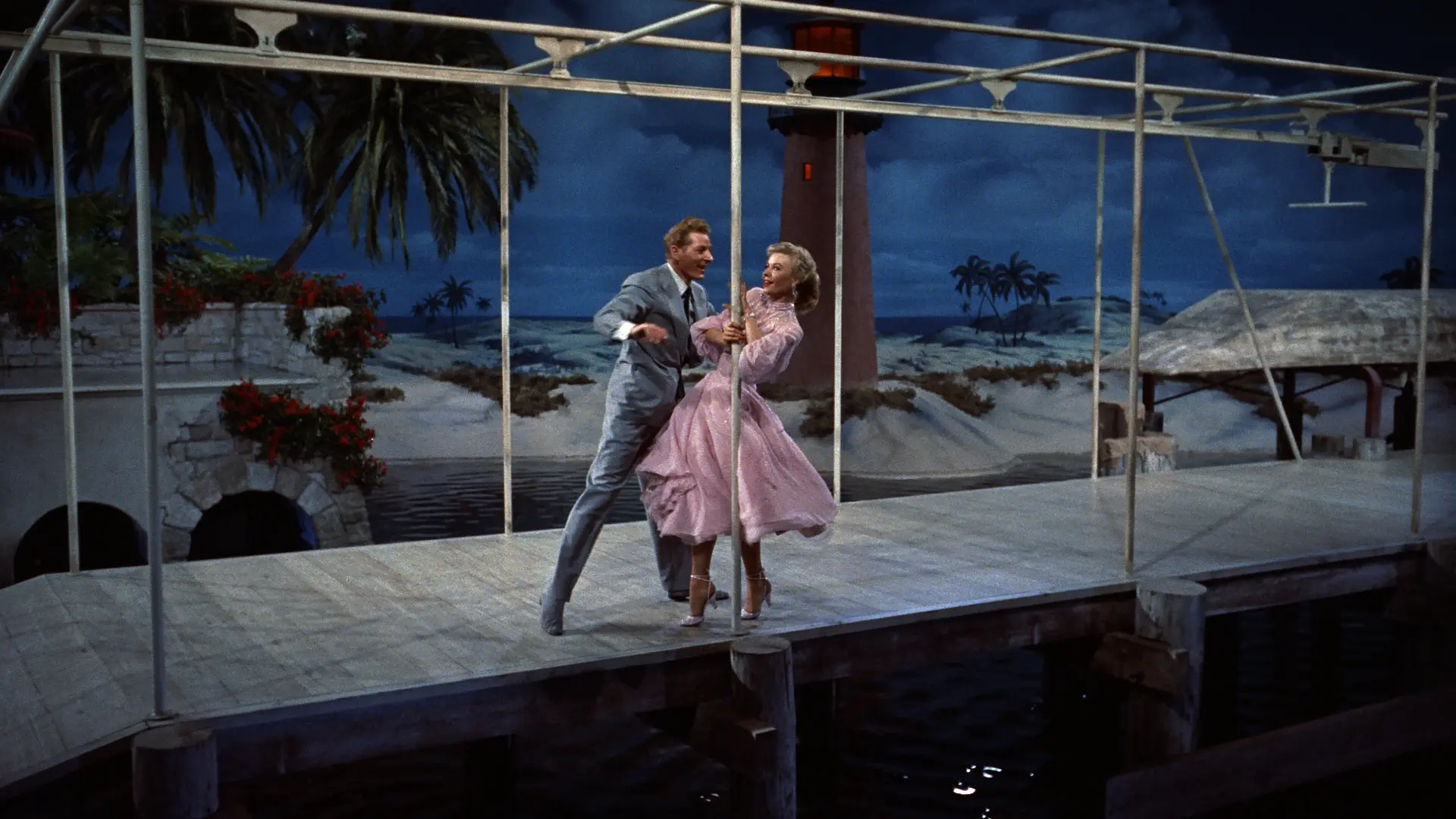
For those who haven’t seen it, White Christmas tells the story of two army buddies: Bob Wallace (Bing Crosby) and Phil Davis (Danny Kaye), who, after World War II, become a famous nightclub act. When they find themselves at a snowless Vermont inn—owned by their former general and just days before Christmas—the boys, along with two charming performing sisters (Rosemary Clooney and Vera-Ellen), take it upon themselves to stage a musical extravaganza to help their kindhearted old commander. It’s the classic “let’s put on a show” plot, but that hardly matters when the songs are this good, the performances this charismatic, and, of course, the clothes are such a treat for the eyes.
Vertigo (1958)
If you thought the costumes in Roman Holiday were subtle, wait until you see Vertigo. I won’t go too deep into the plot—because for those who haven’t seen it, it’s best experienced with as little knowledge as possible (though fair warning: slight spoilers ahead). What you need to know is that Kim Novak plays dual roles, and her characters are defined as much by their wardrobes as by their actions—a testament to Edith Head’s impeccable costume storytelling.
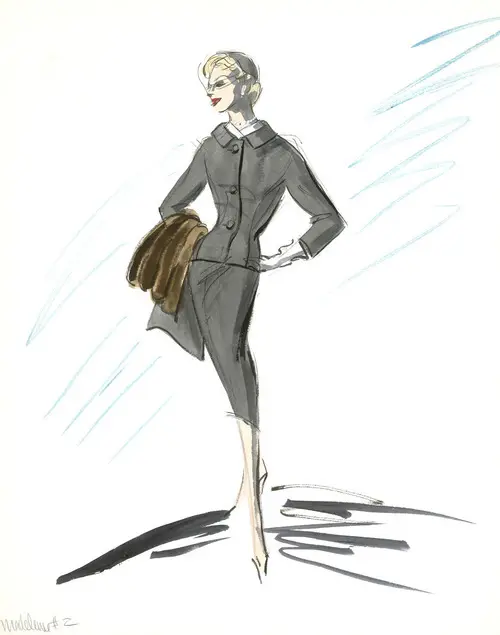
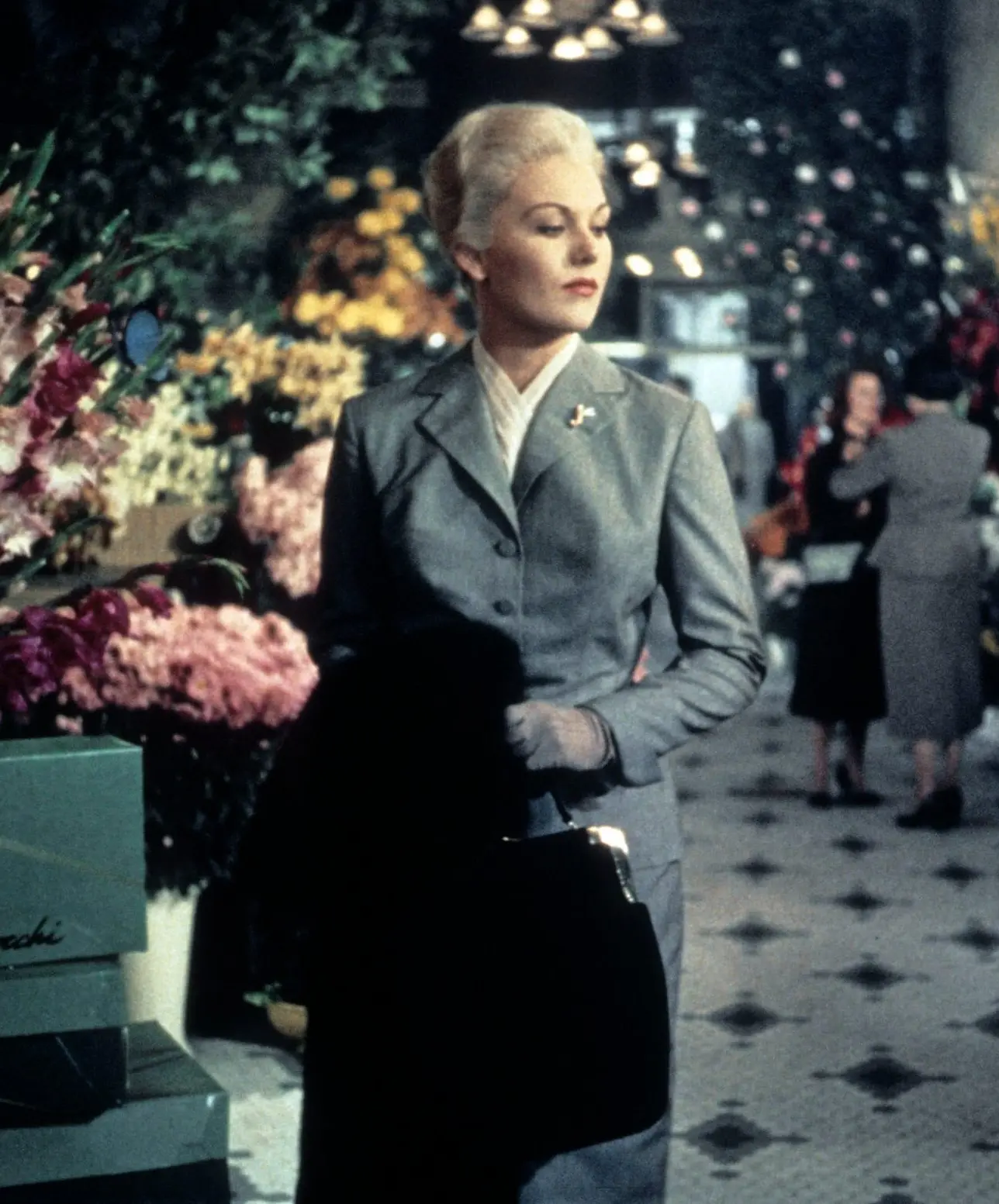
Her first role, Madeleine, is memorably dressed in an elegant, tailored gray suit: a choice that emphasizes her mystery and cool detachment. Novak reportedly hated the suit, finding its fabric stiff and its fit restrictive. She pleaded with Hitchcock to change it, but he refused—and rightly so. Novak later conceded that the discomfort it caused her ultimately ended up serving the performance, making Madeleine appear not only reserved but also uneasy in her own skin. Her second character, Judy, is the opposite: warmer, looser, and dressed in more form-fitting, colorful outfits that signal her softer, approachable nature.
Today, the costumes of Vertigo are often remembered as quintessentially elegant, and they are. But part of their reputation also comes from the tendency to romanticize anything from Hollywood’s golden age, especially in films directed by the Master of Suspense. What truly makes them brilliant, however, is not their elegance but their purpose: Edith Head’s costumes are narrative instruments, deliberately used to sharpen the film’s central themes of identity and desire.
What a Way to Go! (1964)
We’ve spoken about subtlety on this list, and we’ve talked about classic elegance—but have you seen Edith Head go completely bonkers maximalist? Well, I have—and that’s thanks to What a Way to Go!: the most underseen film on this list, but one that deserves a lot more attention because it’s funny, well-performed, and incredibly stylish. Luckily, it’s available to watch for free on YouTube!
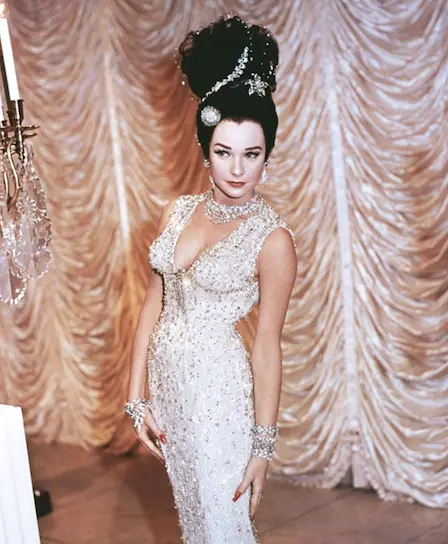
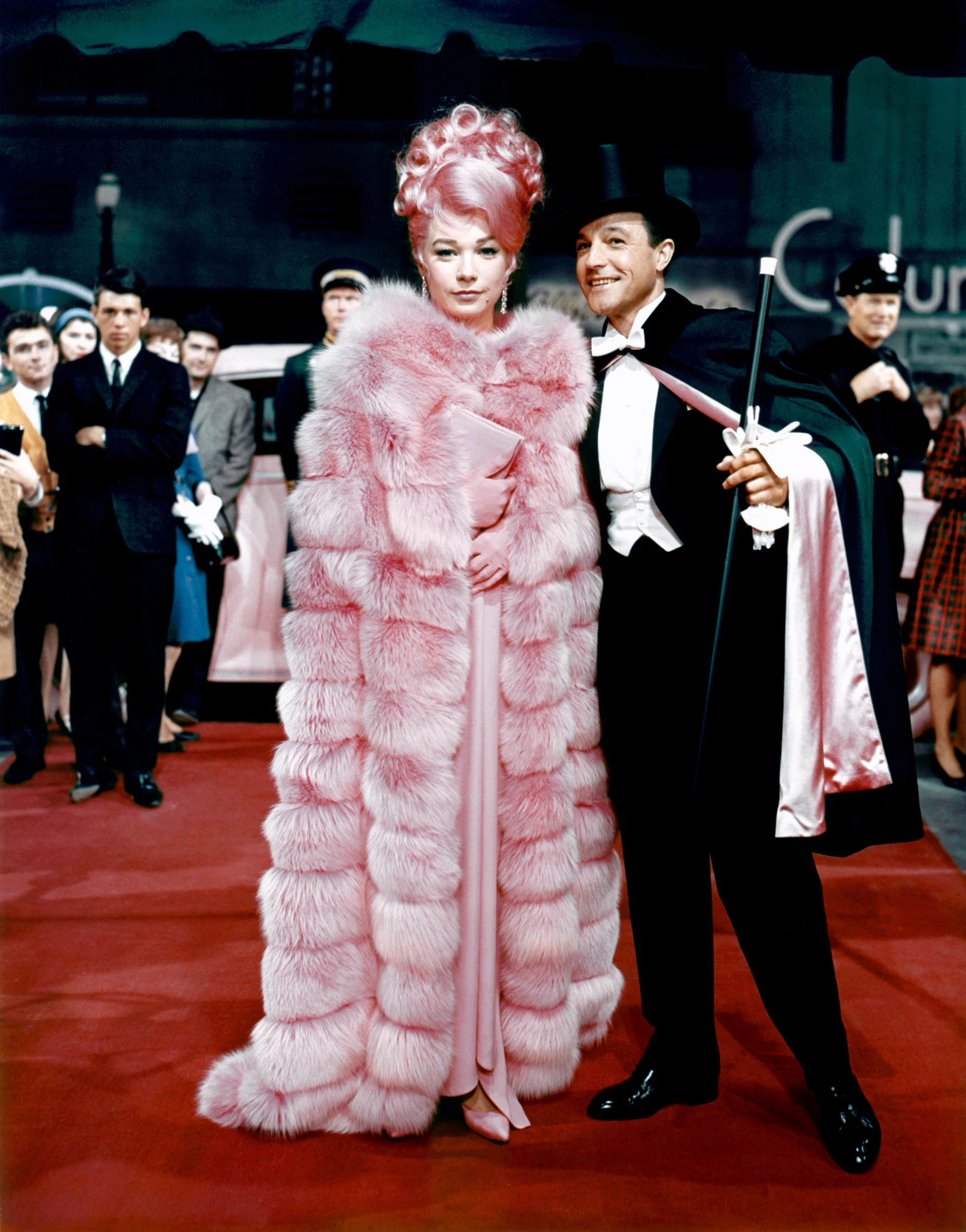
The film follows Louisa May Foster (a charming Shirley MacLaine), who, after trying to give away her $200 million fortune to the military, explains to a psychiatrist why she’s so unhappy: she’s had four husbands, all of whom became incredibly wealthy, only to die in bizarre accidents she believes were caused by a curse. Sounds dark, but it’s actually a wickedly funny comedy, bursting with great fashion moments. Shirley and Edith Head—working with an unlimited budget from 20th Century Fox (Head was loaned out from Paramount for the project)—were given free rein to go wild.
Think: leather gowns, fur-drenched ensembles, endless trains with hand-painted details, the biggest wigs and hats you’ll ever see, and diamonds dripping everywhere. It’s glorious, campy fun that earned Head yet another one of her 35 Oscar nominations. This time, she shared it with veteran costume designer Moss Mabry, who handled the men’s wardrobes.
The Sting (1973)
By the 1970s, Head was still hard at work—this time at Universal—where she continued to create striking costumes for late Hitchcock films and big-budget disaster movies with sprawling ensemble casts. It was truly the twilight of her career, yet the legendary costumer still had one more Oscar win left in her. Surprisingly, her final victory did not come from a film overflowing with elegant gowns and dresses, but from a picture centered on menswear.
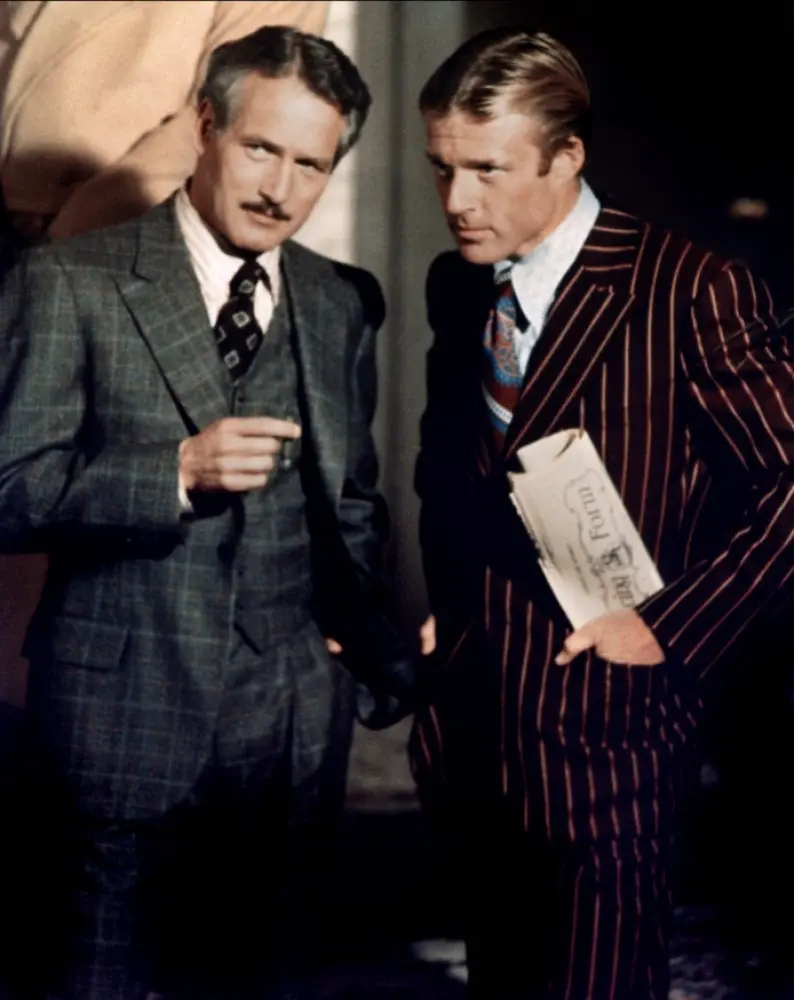
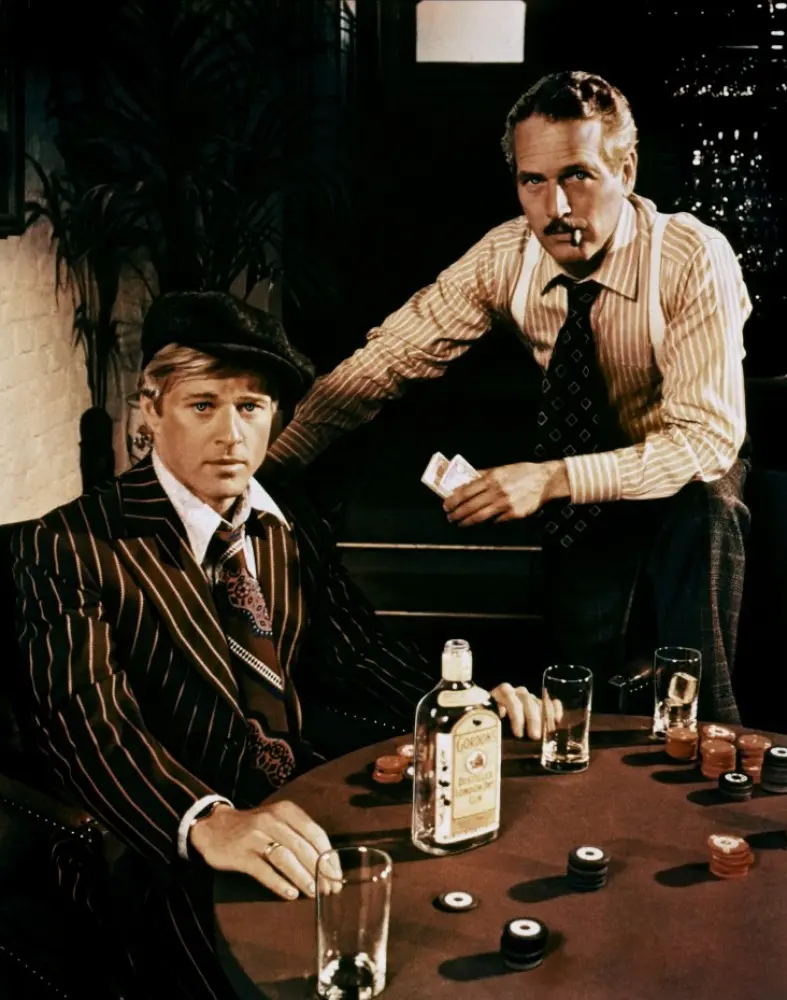
Head dressed, whom she called “two of the most handsome people in the world,” Paul Newman and Robert Redford, in The Sting, George Roy Hill’s Best Picture-winning caper. They play Henry Gondorff and Johnny Hooker, respectively, two grifters who combine their skills for the heist of a lifetime. The contrasting personalities of the characters gave Head a perfect opportunity to play with clothing: Newman’s Henry is slick and cunning, while Redford’s Hooker is rugged and street-smart. The result? Menswear moments worth remembering. Head’s sharply tailored suits, custom hats, dashing tuxedos, and pin-striped ensembles rank among the finest men’s clothing ever seen on film during the 1970s.
